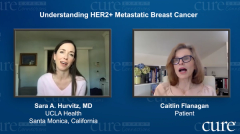
Advances in HER2+ Metastatic Breast Cancer
Sara A. Hurvitz, M.D., reviews the advances in HER2+ metastatic breast cancer that have been made over the past decade.
Episodes in this series

Sara A. Hurvitz, M.D.: There have been a number of advances since we first met. Trastuzumab was FDA-approved for advanced, or stage 4, breast cancer in 1998. Then lapatinib was approved in 2007, so it took almost 10 years for a second HER2 [human epidermal growth factor receptor 2]-targeted therapy to be approved. In 2012 and 2013, we had 2 more agents. Then, as we jump to 2019 and 2020, we have a slew of new approvals. It is an exciting time, but it also can be a bit of a confusing time for clinicians who are treating stage 4 breast cancer because there are so many options.
We now always start in the metastatic setting with a taxane, like you got, and trastuzumab, and we combine it with pertuzumab. If you were diagnosed today with stage 4, that would be the regimen, which is pretty similar to what you had. As the second-line therapy, the standard of care is TDM1 [trastuzumab emtansine], which is what you received. The toxicity you experienced was quite significant, which is why we took you off of it. Not everybody has that experience, but you experienced significant toxicities from it. If I’m recalling correctly, it was neuropathy, nausea, and your liver wasn’t happy.
So we switched you to the trastuzumab/pertuzumab and endocrine therapy since you’re triple-positive. Your tumor has estrogen receptors, as well as the HER2. That worked for a good long time.
Caitlin Flanagan: That was easy.
Sara A. Hurvitz, M.D.: Yes, you felt great on that.
Caitlin Flanagan: Yes, I did.
Sara A. Hurvitz, M.D.: But now, in the third-line setting and beyond, we have all of these therapies from which to choose. How to sequence them is tricky, because we don’t have any clinical trials saying, “If you do this one third and this one fourth, and this one fifth, patients will live longer than if you do it in this reverse order,” so we have to use the side effect profile and what we know about the drug’s activity. Some of these drugs penetrate the blood-brain barrier and actually prevent brain metastases or delay the presentation of brain metastases. About 30% to 50% of patients with HER2-positive breast cancer can develop brain metastases, so this is a huge area of unmet need, and that’s really exciting that we have agents that do that now.
Then, we have another drug like TDM1. It really packs a punch. It’s a very active therapy, but it has side effects associated with it like pneumonitis, which is inflammation of the lungs. We wouldn’t want to give it to somebody who has underlying issues with their lungs, like pulmonary fibrosis or a history of pneumonitis.
We use a lot of individual patient factors—where the disease is, how healthy the patient is, what other problems the patient has in their medical world, diabetes, high blood pressure, heart disease—to help us decide. Then, of course, we factor in the patient’s goals; as you stated, goals of wanting to be alive as long as possible, but also measured against the side effect profile of each of these agents.
In my own practice, after TDM1, I will use either tucatinib/capecitabine/trastuzumab, which was FDA-approved last year in 2020, or I will use TDXd [trastuzumab deruxtecan], which is the antibody-drug conjugate. For you, I was concerned about the toxicity of the TDXd, given how hard TDM1 was for you. You didn’t have a huge disease burden at your time of progression, so I didn’t feel like I needed to give you something that was really tough that was going to knock the disease back. And the data regarding tucatinib are quite phenomenal. It’s been shown to not only lengthen the time a woman can live with this disease without it being out of control, but it also improves survival, and it improves survival in patients with active brain metastases—it may be providing protection there. That’s why I made that recommendation.
But when I first told you about the regimen, do you recall our conversation or what I told you about the drugs?
Caitlin Flanagan: I had a scan after having my numbers going up. Then you called and said, “We need to talk today.” I thought, “Uh-oh.” You said I could come in or call, and I called. You were like, “OK, great. It’s Sara. I’m in the room, and Maddie’s in the room,” and I thought, “Oh, this is really scary.“
But then it wasn’t that scary because you said very gently, “Well, there are some nuances in the scan. We should treat these nuances, but nothing’s really bad or terrible right now.” You started going through all the different things, but I remembered the one, I think it was the first one you mentioned, about the brain. My whole life is reading and writing. I’m a writer. I’m sure everybody is most terrified of brain metastases. But everything about it frightens me, like not being considered compos mentis to make any end-of-life decisions. I’m really afraid of brain metastases.
When you had said that this one was particularly made, or that was a particular feature, I thought, “That one sounds good. What do you think?” You said, “Yes, I think that’s why I said that first, because that would be a good choice.”
Transcript edited for clarity.





